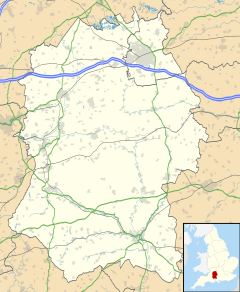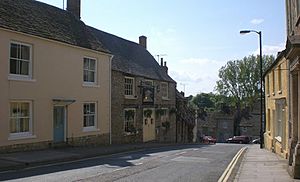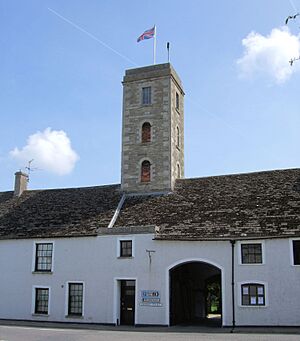Malmesbury facts for kids
Quick facts for kids Malmesbury |
|
|---|---|
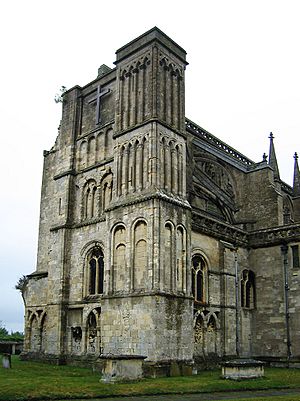 Malmesbury Abbey |
|
| Population | 5,969 (2021 Census) |
| Demonym | Jackdaws (in informal contexts—blason populaire) |
| OS grid reference | ST940857 |
| Unitary authority |
|
| Ceremonial county | |
| Region | |
| Country | England |
| Sovereign state | United Kingdom |
| Post town | Malmesbury |
| Postcode district | SN16 |
| Dialling code | 01666 |
| Police | Wiltshire |
| Fire | Wiltshire |
| Ambulance | Great Western |
| EU Parliament | South West England |
| UK Parliament |
|
Malmesbury is a historic town in north Wiltshire, England. It's about 14 kilometres (9 miles) west of Swindon and 25 kilometres (16 miles) northeast of Bristol. The oldest part of the town sits on a hilltop. This hill is almost surrounded by the Bristol Avon river and one of its smaller branches.
Long ago, Malmesbury was an Iron Age fort. Later, in the early Middle Ages, it became home to Malmesbury Abbey, a famous learning centre. It was also one of Alfred the Great's special fortified towns, called burhs, built to defend against the Vikings. Æthelstan, the very first king of all England, was buried in the abbey when he died in 939. Malmesbury grew into an important market town in the Middle Ages, known for its abbey and education.
Today, Malmesbury is still famous for its abbey. Most of the abbey survived the time when monasteries were closed down in England. The town's economy relies on farming and tourism, especially because it's near the beautiful Cotswolds. Dyson, a well-known technology company, is the biggest employer in Malmesbury. In 2021, nearly 6,000 people lived in the town.
Malmesbury's Past
The hilltop where Malmesbury stands has many fresh springs. These springs helped early people settle there. It was once an Iron Age fort. In the Anglo-Saxon period, a monastery here became a famous place for learning. The town is listed in the Burghal Hidage, a document from Alfred the Great's time. It shows Malmesbury was one of his defended burhs. Its old Iron Age walls helped protect it from Viking attacks.
The town was mentioned in the Domesday Book of 1086 as a borough. Alfred's grandson, Æthelstan, who was the first king of England, was buried in Malmesbury Abbey in 939.
The Famous Malmesbury Abbey
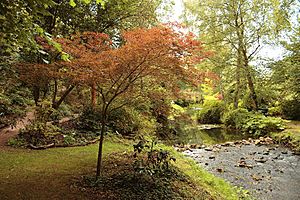
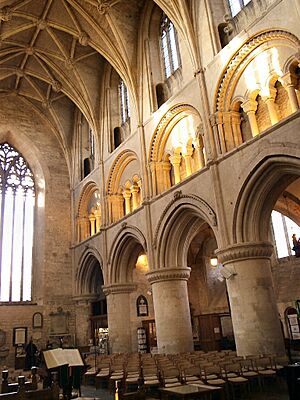
The Abbey was started in 675 by an Irishman named Maildubh. The town's name, Malmesbury, comes from Maildubh and burh, meaning "Maildubh's fortification". After Maildubh died, St Aldhelm became the first abbot. He built the first church organ in England! It was described as a "mighty instrument" with many sounds. St Aldhelm died in 709 and became a saint. The Abbey's architecture is very important and is a protected ancient site.
A monk named Eilmer of Malmesbury tried to fly from a tower at the Abbey in 1010. He used a simple hang glider. Eilmer flew over 180 metres (about 600 feet) before landing. He broke both his legs, but it was an amazing early attempt at human flight!
By the time the Normans invaded in 1066, Malmesbury was one of England's most important towns. King Henry I's chancellor, Roger of Salisbury, took control of the monastery in 1118. He rebuilt the town's wooden walls with stone. He also built Malmesbury Castle at the same time.
In the Middle Ages, the northern part of the town grew as a religious centre. This led to the building of the third Abbey on the site in the 12th century. This Malmesbury Abbey once had a spire 7 metres (23 feet) taller than the one at Salisbury Cathedral. The Abbey's guest house, built in 1220, is now The Old Bell hotel. It claims to be the oldest hotel in England. The Abbey's tall spire fell down in the late 1400s or early 1500s. Later, King Henry VIII sold most of the Abbey's land. The part of the Abbey that still stands is now the local church.
People from Malmesbury are sometimes called "Jackdaws". This nickname comes from the many Jackdaw birds that live on the Abbey walls and roof.
Battles and Changes
Malmesbury was on the border between two old kingdoms: Mercia to the north and Wessex to the south. This caused many disagreements between towns for centuries. Malmesbury's location and strong defences made it a key military spot.
During a civil war in the 12th century, the armies of King Stephen and his cousin Empress Matilda faced each other across the River Avon at Malmesbury. A peace agreement was made after this standoff in 1153.
During the English Civil War, the town was captured seven times by different sides. You can still see marks from cannons and gunshots on the south side of Malmesbury Abbey today. In 1646, the town walls were ordered to be destroyed. As peace returned to England, Malmesbury lost its importance. New transport routes and trade centres developed elsewhere. The town became a smaller, regional market town.
Malmesbury Commoners: A Special Tradition
At the Battle of Brunanburh in 937, King Æthelstan of Wessex defeated a large army. Many men from Malmesbury helped him. To thank them, King Æthelstan gave the townsfolk their freedom. He also gave them 600 hides of land south of the town.
The special status of "freemen of Malmesbury" has been passed down through families for generations. It still exists today! For a long time, only sons or sons-in-law could become freemen. But since 2000, daughters of freemen can also join. There can be up to 280 commoners. The group, called The Warden and Freemen of Malmesbury, still owns land and many properties in the town. They provide affordable homes for local people.
Town Life and Services
Malmesbury has many public services. The Wiltshire Police force keeps the town safe. Fire services are provided by the Dorset & Wiltshire Fire and Rescue Service. Ambulance services come from the South Western Ambulance Service. The town also benefits from the charity-funded Wiltshire Air Ambulance.
There is a local doctor's surgery, Malmesbury Primary Care Centre. For bigger health needs, residents can go to hospitals in Swindon, Bath, or Salisbury. There are also smaller injury units nearby in Tetbury and Chippenham.
Waste management and recycling are handled by Wiltshire Council. Electricity is supplied by Western Power Distribution. Wessex Water provides drinking water and manages the sewers.
Malmesbury's Location
Malmesbury is located on a flat hilltop in the Cotswolds. Two rivers meet here. The (Bristol) Avon flows from the west. Another branch, sometimes called the Tetbury Avon, comes from the north-west. These rivers flow very close to each other, but a narrow, high strip of land separates them. This creates a rocky, gently sloping hilltop. The two rivers finally meet on the southern edge of the town. Because of its steep, sometimes cliff-like sides, Malmesbury was described as one of the best naturally defended inland places.
In recent times, the town has grown. New areas have been built to the north and north-west.
Malmesbury's Economy

Malmesbury has always been a market town for the surrounding farming areas. Even today, the High Street has many independent shops. There is also a weekly farmers' market.
After the monasteries were closed in 1539, Malmesbury's economy changed. The town turned to the wool spinning and weaving industry. It had plenty of wool and water. Later, it became a centre for lace-making. However, the very things that made it a strong religious and defensive centre – water on three sides and steep cliffs – made it hard for modern transport like canals and railways to reach. So, Malmesbury didn't grow as much as other towns during the Industrial Revolution.
Today, the town's main employer is Dyson. They have a large site on the edge of town, employing about 4,000 people. This site is mainly for research, development, and design. The actual manufacturing is done in Malaysia.
Tourism is also important to Malmesbury's economy. People visit to enjoy the Cotswold Hills, tour the Abbey, see nearby landmarks, or attend festivals.
In 1998, Malmesbury had a funny and famous event. Two Tamworth pigs, known as the Tamworth Two, escaped from the town's slaughterhouse. They swam across the river and lived in an orchard for a week. Their story made international news! The pigs were eventually caught and lived happily at an animal rescue centre.
EKCO Factory History
During the Second World War, an electronics company called EKCO moved some of its work to Malmesbury. They wanted to avoid bombing in Southend-on-Sea. They set up a factory to make radar equipment, which was a new technology then. The factory continued after the war and was later owned by Philips and AT&T. The site was used as offices until 2004 and is now housing.
Fun and Community
Malmesbury has an exciting annual carnival in August. It includes many events, ending with a big parade through the town on the last Saturday. Started in 1917, the carnival now has over 30 events, from music to fun attempts at world records.
Since 2007, the world music festival WOMAD Charlton Park has been held nearby in Charlton Park. It usually takes place over the last weekend of July.
Community Places
Malmesbury has several public parks and gardens. Three of these, St Aldhelm's Mead, Cuckingstool Mead, and White Lion Recreation Park, are protected as free, open spaces for recreation. The town also has a leisure centre called The Activity Zone and a public library. A mobile library also visits the town.
Sports and Hobbies
Malmesbury has a local football team, Malmesbury Victoria F.C., who play at The Flying Monk Ground. They are part of the Hellenic Football League. There's also a swimming club, Malmesbury Marlins, and a cricket club, Malmesbury Cricket Club, with teams for both adults and juniors.
Twin Towns
Malmesbury is twinned with:
- Gien, France
- Niebüll, Germany
It also has friendship agreements with:
- Bad Hersfeld, Germany
- Cherkasy, Ukraine
- Malmesbury, South Africa
Religion in Malmesbury
Church of England
Malmesbury Abbey has been the local parish church since 1541. It took over from the earlier St Paul's church. The Abbey is dedicated to Saint Peter and Saint Paul.
Roman Catholic Church
The local Roman Catholic church is St Aldhelm's Church. It is named after St Aldhelm, who lived in Malmesbury.
Other Churches
Malmesbury also has a United Reformed Church and The King's Church. There are also older churches that are no longer used for worship, like a former Moravian church which is now a museum building.
Malmesbury's Landmarks
Malmesbury's unique layout and many historic buildings are due to its water defences. The town centre still follows the Saxon plan rebuilt by Roger of Salisbury around 1102. Because it was hard to build modern transport links, the town's old architecture has been largely untouched. This means Malmesbury has many more Grade I and Grade II listed buildings than many other English towns.
Important Grade I Listed Buildings
The town has six Grade I listed buildings, which are the most important historical structures.
Malmesbury Abbey
The part of the 12th-century abbey church that still stands is now the local church. It was built with limestone. Between 1350 and 1450, the building was made bigger, and a tall spire was added. This spire fell in 1479. After the monasteries were closed, William Stumpe changed the building to become the parish church.
A special part of the Abbey is its south porch. It is richly carved with scenes from the Bible. Experts say it's "among the best pieces of Norman sculpture and decoration in England."
Market Cross
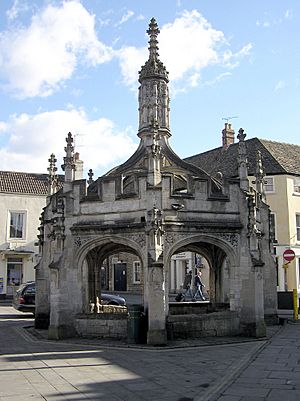
In the town centre stands the market cross, built around 1490. It might have used stone from the ruined parts of the abbey. An old writer, John Leland, described it in the 1540s as a "right fair and costely piece of worke." It was built to shelter "poor market folks" when it rained. This beautifully carved, eight-sided building is one of the best-preserved of its kind in England. It's still used as a public shelter today and is nicknamed "The Birdcage" because of how it looks.
St Paul's Bell Tower
The 15th-century tower is all that remains of St Paul's church. This church used to be next to the abbey and was the town's parish church until 1541. The main part of St Paul's church collapsed by the early 1500s. The tower is now used as the bell tower for the Abbey.
Abbey House
Abbey House was rebuilt around 1540 by William Stumpe. It stands on the site of a 13th-century building within the abbey grounds. The beautiful Abbey House Gardens around it were replanted in 2022 and are sometimes open to visitors.
The Old Bell Hotel
This building was once the guest house for the abbey, dating back to the early 13th century. It was changed and extended later. From about 1530, William Stumpe used it as a cloth mill. Today, it is The Old Bell hotel. It claims to be the oldest hotel in England that was built as a hotel and is still in use today.
Former Court House
In the south of the town, there was a hospital called St John the Baptist from the 13th century. In the 1500s, the town bought the hospital. Part of it was used for court meetings from 1616. This former court house is now part of a home. Nearby, you can see the 12th-century entrance arch of the hospital and 16th-century almshouses, which were used until 1948. They are now three cottages.
Other Interesting Buildings
Tower House
Tower House is a large, old building that is now a private home. It stands at the end of Oxford Street. It has a high-roofed main hall where it is said King Henry VIII once ate after hunting. In the 1840s, a doctor who lived there and loved astronomy built a tall, narrow tower on the roof. This building is very noticeable on the eastern skyline of the town.
St Aldhelm's Roman Catholic Church
St Aldhelm's Church is a Catholic church built in 1875. It is named after the town's patron saint and is connected to the local Catholic primary school, St Joseph's.
War Memorial
A war memorial was put up in The Triangle in 1921 after the First World War. It is a celtic cross inspired by the Cross of St Martin on the island of Iona. The cross is made of different types of stone.
Getting Around Malmesbury
The A429 road goes around the eastern edge of Malmesbury. This road connects the town to the M4 motorway to the south and to Kemble railway station and Cirencester to the north. Before this bypass was built, the main road went right through the High Street.
Three smaller roads, called B roads, also meet in Malmesbury. These are the B4014 to Tetbury, the B4040 to Sherston, and the B4042 to Royal Wootton Bassett.
Malmesbury railway station opened on 17 December 1877. The train line connected Malmesbury to the main London-Bristol line. The station closed to passengers in 1951 and to freight in 1962. The tracks were later removed, and the old station site is now an industrial area.
Today, the closest train stations are:
- Kemble on the Golden Valley Line
- Chippenham on the Great Western Main Line
- Swindon on the Great Western Main Line
The town's bus services are run by Coachstyle. They have a local town service and routes to places like Swindon, Yate, Chippenham, and Cirencester.
Media and News
Local news and TV shows for Malmesbury come from BBC West and ITV West Country. Radio stations include BBC Radio Wiltshire, Heart West, and Greatest Hits Radio South West. The town also has local newspapers like the Gazette and Herald and the Wilts and Gloucestershire Standard.
Learning in Malmesbury
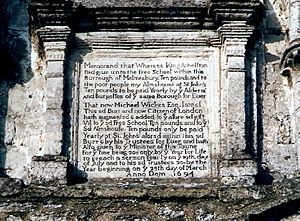
Malmesbury has two primary schools: Malmesbury Church of England Primary School and St Joseph's Roman Catholic Primary School. There is also a secondary school, Malmesbury School, which started in 1971.
In 2017, the Dyson Institute of Engineering and Technology was founded by James Dyson. This higher education college is located on the Dyson campus. The Dyson Institute Village was built in 2019 to provide student housing on campus.
Famous People from Malmesbury
- Maildubh – An Irish saint and monk, who the town of Malmesbury is named after.
- Aldhelm – A Saxon scholar, bishop, poet, and musician. He was the Abbey's first abbot.
- King Æthelstan – The first king of all England.
- Eilmer of Malmesbury – A monk famous for his early attempt at gliding flight.
- William of Malmesbury – A monk and important historian.
- William Stumpe – A cloth merchant who bought Malmesbury Abbey after the monasteries were closed.
- Alice Seeley Harris – A missionary and photographer.
- Thomas Hobbes – A very important British philosopher.
- Hannah Twynnoy – A barmaid who is said to be the first person killed by a tiger in Britain.
- James Constable – A footballer.
See also
 In Spanish: Malmesbury para niños
In Spanish: Malmesbury para niños


